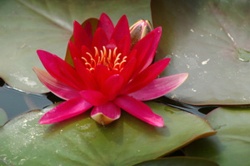Three Natures
Three natures (Skt. trisvabhāva; Tib. མཚན་ཉིད་གསུམ, རང་བཞིན་གསུམ་, Wyl. mtshan nyid gsum or rang bzhin gsum) — the three categories into which the followers of the Mind Only school divide all phenomena:
- Imputed (Skt. Parikalpita; Tib. ཀུན་བརྟགས་, Wyl. kun btags)
- Dependent (Skt. Paratantra; Tib. གཞན་དབང་, Wyl. gzhan dbang)
- Truly Existent (Skt. Pariniṣpanna; Tib. ཡོངས་གྲུབ་, Wyl. yongs grub)
Alternative Translations
- Imaginary, Other-dependent & Perfect (Karl Brunnhölzl)
- Imagined, Other-dependent & Consummate (Jay L. Garfield)
- Imputation, Dependence & the Absolute (Lama Chökyi Nyima)
Further Reading
- Jay L. Garfield, 'Vasubandhu's Treatise on the Three Natures' in Empty Words: Buddhist Philosophy and Cross-Cultural Interpretation, Oxford University Press, 2002
See Also
The theory of the three natures is one of the central concepts of Yogacara philosophy. Although there is just one world it can be perceived in three ways, hence three natures also known as the "three characteristics". The three natures are a perspective on experience "...both a type of real or supposed knowledge, and a degree of reality that this knowledge relates to." All three natures are involved in direct perception and "...represent all states of entities without exception."
1) The imaginary nature is constructed of subject/object discriminations. It is the nature that accepts the reality of the "self". In Yogacara theory all objects, internal and external, are constructs which only exist as part of our awareness, so their nature is imaginary. There is no reality in this nature, it is just illusion. This nature accepts the validity of the illusory, i.e., that happiness depends on having a new car. The imaginary nature believes in the reality of the the water in a mirage.
2) The other-dependent or interdependent nature is the basis from which the imaginary nature arises and the perfected nature appears. The other-dependent nature is produced by "...the flow of changing mental phenomena...that arise from causes and conditions." These dharmas are real (as conditional things), but "because we impose an imaginary 'self-existence' upon our experience of them, we come up with distorted images...[of] things...." This causes suffering (samsara), since our mental constructs do not match reality. The other-dependent nature is the mirage itself.
3) The perfected or fulfilled nature is the ultimate nature; the only one that is absolutely real. However, it is "...neither the same as, nor different..." from the other-dependent. The perfected nature is devoid of duality and sees the world as "representation only". Since it is always exactly the same, it is the "thusness" of all. The perfected nature knows it is seeing a mirage.
To see the inter-relationship of our mind processes (i.e.; the other-dependent nature) as being without real objective qualifications of their own (imaginary nature) is to be enlightened (perfected nature). Once the false concept of "I" and "object" is removed, the result is "things-as-they-are", which is nirvana.

